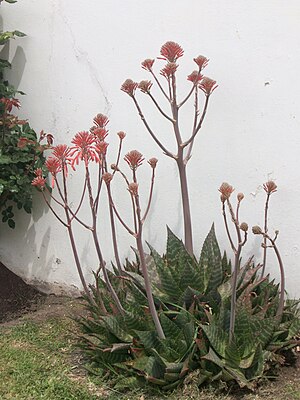Aloe maculata
| Aloe maculata | ||||||||||||
|---|---|---|---|---|---|---|---|---|---|---|---|---|

Aloe maculata |
||||||||||||
| Systematics | ||||||||||||
|
||||||||||||
| Scientific name | ||||||||||||
| Aloe maculata | ||||||||||||
| Alles. |
Aloe maculata is a species of aloes in the subfamily of the Affodilla family (Asphodeloideae). The specific epithet maculata comes from Latin and means 'spotted'.
description
Vegetative characteristics
Aloe maculata grows without a stem or with a short stem, is single or sprouts and then forms dense groups. The trunks are up to 50 centimeters long. The twelve to 20 lanceolate leaves form dense rosettes . The green leaf blade is 25 to 30 inches long and 8 to 12 inches wide. There are numerous elongated, cloudy white spots on the leaf surface. The lined underside usually has no spots. The brown, stinging teeth on the leaf margin are 3 to 5 millimeters long and about 10 millimeters apart.
Inflorescences and flowers
The inflorescence consists of three to seven branches and reaches a length of 40 to 100 centimeters. The dense, head-like, evenly-shaped, occasionally conical or round-topped grapes are 10 to 12 centimeters long and 12 to 16 centimeters (rarely from 8 centimeters) wide. The deltoid pointed bracts are about a third to half as long as the flower stalks . The usually salmon pink to orange, occasionally yellow or red flowers are on 35 to 45 millimeters (rarely from 25 millimeters) long peduncles. They are 35 to 45 millimeters long and trimmed at their base. At the level of the ovary , the flowers have a diameter of 10 millimeters. Above this they are abruptly narrowed to 6 millimeters and finally widened to the mouth. Your tepals are not fused together over a length of 10 to 15 millimeters. The stamens and the stylus barely protrude from the flower.
genetics
The number of chromosomes is .
Systematics and distribution
Aloe maculata is common in Lesotho , the South African provinces of Eastern Cape , Free State , KwaZulu-Natal , Mpumalanga and Western Cape as well as in Swaziland on grasslands on rocky slopes at heights of up to 1830 meters.
The first description by Carlo Allioni was published in 1773.
The following taxa were included as synonymous in the species: Aloe saponaria var. Saponaria , Aloe perfoliata var. Θ L. (1753), Aloe perfoliata var. Λ L. (1753), Aloe disticha Mill. (1768, nom. Illeg. ICBN -Article 53.1), Aloe maculosa Lam. (1783), Aloe maculata Medik. (1786, nom. Illeg. ICBN -Article 53.1), Aloe perfoliata var. Saponaria Aiton (1789), Aloe saponaria (Aiton) Haw. (1804), Aloe umbellata DC. (1802), Aloe saponaria var. Latifolia Haw. (1804), Aloe latifolia (Haw.) Haw. (1812), Aloe leptophylla N.E.Br. ex Baker (1881), Aloe leptophylla var. brachyphylla Baker (1896) and Aloe leptophylla var. stenophylla Baker (1896).
The following subspecies are distinguished:
- Aloe maculata subsp. maculata
- Aloe maculata subsp. ficksburgensis (Reynolds) Gideon F.Sm. & Figueiredo
proof
literature
- Susan Carter , John J. Lavranos , Leonard E. Newton , Colin C. Walker : Aloes. The definitive guide . Kew Publishing, Royal Botanic Gardens, Kew 2011, ISBN 978-1-84246-439-7 , pp. 171 .
- Leonard Eric Newton: Aloe maculata . In: Urs Eggli (Hrsg.): Succulent lexicon. Monocotyledons . Eugen Ulmer, Stuttgart 2001, ISBN 3-8001-3662-7 , pp. 155-156 .
Individual evidence
- ↑ Urs Eggli, Leonard E. Newton: Etymological Dictionary of Succulent Plant Names . Springer, Berlin / Heidelberg 2010, ISBN 978-3-642-05597-3 , p. 144.
- ↑ Carlo Allioni: Auctuarium ad Synopsim Methodicam Stirpium Horti Regii Taurinensis . Turin 1773, p. 13.
- ↑ Gideon F. Smith, Estrela Figueiredo, Ronell R. Klopper, Neil R. Crouch: Aloe maculata All. (Asphodelaceae) in the Free State Province, South Africa, and resurrection of 'var. ficksburgensis'. In: Bradleya . Volume 30, 2012, p. 15.
Web links
- Aloe maculata in the Red List of South African Plants

